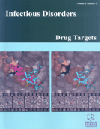-
oa Editorial [Hot Topic: Subcellular Trafficking of Pathogens: Targeting for Therapeutics (Guest Editors: Gregory W. Moseley and David A. Jans)]
- Source: Infectious Disorders - Drug Targets (Formerly Current Drug Targets - Infectious Disorders), Volume 12, Issue 1, Feb 2012, p. 2 - 3
-
- 01 Feb 2012
Abstract
Conventional therapies for microbial infection including vaccines, antibiotics and antivirals principally target specific properties of the microbe, such as antigen expression, attachment proteins for host cell interaction and entry, and microbial enzymes involved in replication and assembly. The efficacy of such approaches to protect human populations from disease is limited by the ability of known microbial pathogens to mutate in order to evade immune detection or circumvent the activity of antimicrobial drugs, and also by the emergence of novel, previously uncharacterised, lethal microbes/strains, exemplified by zoonotic diseases such as SARS and influenza. As a result, increasing research effort has focussed on the molecular basis of host:pathogen interactions, with a view to identifying novel therapeutic targets. Central to the biology of intracellular pathogens (viruses and certain bacteria, protozoa and fungi) are specific interactions with host cell intracellular transport machinery including the cytoskeleton, the nucleocytoplasmic trafficking system, and membrane trafficking systems. These interactions enable cell entry and efficient intracellular trafficking of pathogens to their sites of replication, exemplified by neurotropic viruses that invade the periphery and traffic in neurons to the central nervous system. Furthermore, specific pathogen products have evolved to exploit subcellular trafficking mechanisms to enable targeting to compartments/organelles such as the nucleus and mitochondria, which may be physically separated from the compartment in which the microbe resides and replicates. This enables microbial subversion of fundamental cellular processes including transcription, apoptosis and innate immunity, and, thereby, reprogramming of host cells to create an environment conducive to infection and spread. Thus, these molecular interactions represent promising, as yet unexploited, targets for novel therapeutic approaches. Importantly, because such approaches would target host cell factors and processes, rather than the idiosyncrasies of specific microbes/strains, they would not be readily circumvented by microbial mutation, and may prove broadly applicable for the treatment of infections by diverse pathogens, including newly emerging microbes. Further, because pathogens, including relatively simple viruses, have evolved specific mechanisms to exploit trafficking pathways, their characterisation has made significant contributions to our understanding of complex subcellular trafficking mechanisms underlying normal cell biology. This issue aims to introduce the diversity and importance of host cell subcellular trafficking processes in the biology of human pathogens, and the significance of this area to the development of novel therapies. In the first review, “Tetraspanins: Gateways to Infection,” Peter Monk and Linda Partridge introduce the tetraspanins, a highly conserved protein superfamily with diverse functions in cell biology. The exploitation of tetraspanin functions in numerous human diseases serves to highlight the paradigm that diverse intracellular pathogens including bacteria, viruses, fungi and protozoa can target and modify many fundamental cellular processes including trafficking to facilitate infection, and that these processes can provide targets for intervention. In “Viral Product Trafficking to Mitochondria, Mechanisms and Roles in Pathogenesis”, Williamson et al. discuss the specific targeting of mitochondria by viral products, which provides viruses with the means to modify mitochondrial processes important to cellular metabolism, apoptosis and innate immunity. This enables viral modification of the cellular environment to conditions favourable for replication, regulation of cell death according to viral requirements, and evasion of cellular antiviral systems. The following article, “Subcellular Trafficking in Rhabdovirus Infection and Immune Evasion: A Novel Target for Therapeutics” by Oksayan et al., examines viral cell invasion and subsequent intracellular trafficking via microtubule-dependent transport to reach cytoplasmic viral “factories”, which may be localized at great anatomical distances from the initial infection site. The role of intricately regulated interactions of viral proteins with nuclear trafficking machinery, enabling cytoplasmic viruses to target nuclear functions including immune signalling is also introduced, and its potential for inhibition as a therapeutic strategy is discussed. In Younessi et al. “Modulation of Host Cell Nucleocytoplasmic Trafficking During Picornavirus Infection”, the theme of cytoplasmic virus-expressed protein interactions with the nucleus is further developed, highlighting mechanisms by which proteins from viruses such as polio and rhinovirus not only undergo regulated nuclear trafficking themselves, but specifically target and modify the nuclear trafficking apparatus to direct host cell biology to support viral propagation and suppress antiviral responses. Finally, in “Artificial Viruses: Exploiting Viral Trafficking for Therapeutics”, Dominic Glover describes how our increasing understanding of pathogen subcellular trafficking can have broad medical applications beyond antimicrobial therapy. In this context, pathogens are infiltrators of cellular transport systems that can reveal the mechanisms by which cargoes can be efficiently delivered to specific subcellular sites by regulated interaction with transport machinery. Armed with this knowledge, researchers are constructing tailored nanomachines able to deliver therapeutics to specific organelles, with great promise for the treatment of diseases such as cancer and genetic disorders. Our intention in this special edition is to introduce the theme of subcellular trafficking of pathogens and pathogen products as an essential component in the biology of intracellular pathogens, the exciting possibilities for new generations of therapeutics targeting these processes, and the paradoxical role of human pathogens in revealing the mechanisms of transport systems that have informed basic cell biology and medicine for the production of new drug delivery approaches for non-microbial diseases. We extend our thanks to both the authors and reviewers who have contributed to this project.


